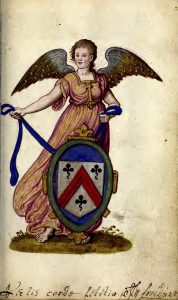As described in Wikipedia, an “album amicorum” was a sixteenth-century “book of friendship” with blank pages on which people collected signatures and messages from people they knew, much as modern students might sign each others yearbooks or fans might collect autographs of famous stars.
Many of these include armorial illustrations, some quite elaborate, giving us a glimpse of another way in which heraldic symbols were used during the Renaissance.
The Album Amicorum of Jean le Clercq, a Belgian university student, dates from the tail end of the sixteenth century, combining pages printed in 1564 containing engraved scenes and stanzas of Ovid translated into French, with other pages hand-painted two decades later showing displays of armory.
The illustrations caught my eye because I’ve been looking for inspiration for non-traditional achievements, and mixed in here among the common form, with its shield and crest-topped helmet, there are others in which the shield is held by an angel or woman, and one with a shield dangling from a wreath with a scroll showing the motto “in vino veritas,” while a lady’s arms on a lozenge appear within the parted drapery of a pavilion-like cover.








